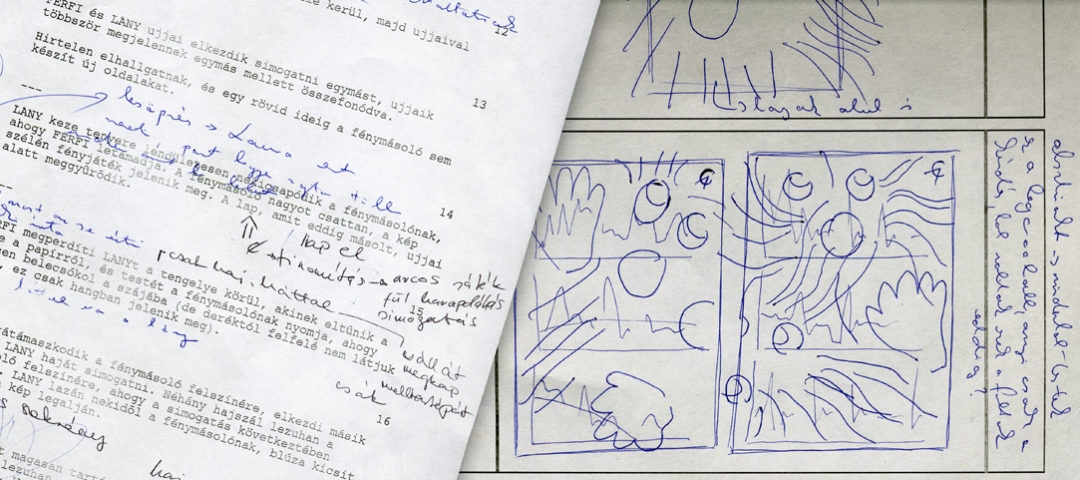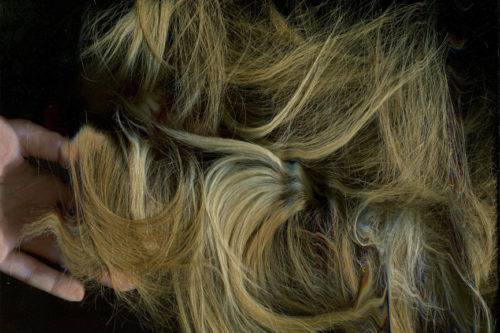
At this point of time, we had no idea what our story will be, because we’ve approached the content from the technology in a formalistic way. One thing we were sure: we only want to use a photocopier for the pictures, we do not want any cameras or drawing tools, limiting the film language as much as possible.
 While tons of ideas have arisen, it has become quite clear that the range of stories which can be told through a photocopier was really limited. Since the machine does not move, it only sees events taking place over it, which is mostly, of course, copying. The futurist film language has enabled the bulky, stupid and stinky tool to show fine emotions and subtle feelings, and we wanted to explore this contrast. Sex on a copier is a rather cliché idea, but it was a perfect setup for our form of language. In addition, we soon realized that looking at long rows of photocopied images overloads the poor viewer’s brain enough already, so it’s better to keep the story as simple as possible.
While tons of ideas have arisen, it has become quite clear that the range of stories which can be told through a photocopier was really limited. Since the machine does not move, it only sees events taking place over it, which is mostly, of course, copying. The futurist film language has enabled the bulky, stupid and stinky tool to show fine emotions and subtle feelings, and we wanted to explore this contrast. Sex on a copier is a rather cliché idea, but it was a perfect setup for our form of language. In addition, we soon realized that looking at long rows of photocopied images overloads the poor viewer’s brain enough already, so it’s better to keep the story as simple as possible.
Thus, the main concept was crystallized: the film will present a sexual act on the top of the copier. Distortions reflect the spiritual status of the protagonists: during the act the bodies are transformed, blended, liquified, and new forms are taken. This will build up until the climax, the orgasm. For a whole day we have not done anything else but planning sexual positions. The task was not simple: as the copier could not be moved, people had to keep moving so that the sight would evolve and escape potential boredom.
 During the tests, it became clear that in the dark world of the photocopier, blond hair van make spectacular images. In the tests, hair seemed to live an independent life on its own. At that time almost all of us worked in a major commercial TV series, here we met Rebeka Valu, an actress who seemed perfect for the role. We did not think about a male protagonist, we felt there will be so little to see that any crew player could actually play him.
During the tests, it became clear that in the dark world of the photocopier, blond hair van make spectacular images. In the tests, hair seemed to live an independent life on its own. At that time almost all of us worked in a major commercial TV series, here we met Rebeka Valu, an actress who seemed perfect for the role. We did not think about a male protagonist, we felt there will be so little to see that any crew player could actually play him.
Besides the people, the film had another protagonist, the pile of paper being photocopied. The original 10-minute screenplay was packed with papers, and it was clear that we needed to pay close attention to their design. So we created Adeptus Consulting, a fictitious company where the whole story is taking place. Adeptus Consulting had a typography, a logo, a corporate visual guide that helped to make the photocopied, seemingly random files look to be part of a system.
To make a movie that has not been tried anywhere in the world has inevitable pitfalls, as we soon realised. The first production plan for The Copyist looked like a one-day shoot, a half-day re-shoot, about a month of post-production, and it’s done. We wanted to it all during the TV season break. We could not even imagine how wrong we were.
Tamás Kőszegi

You must be logged in to post a comment.